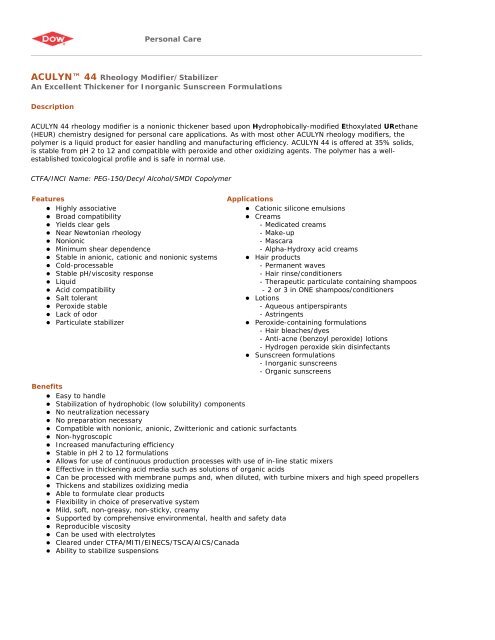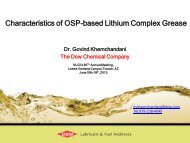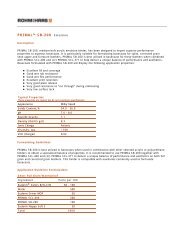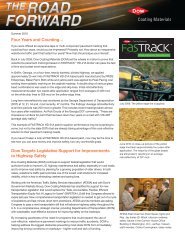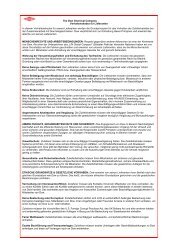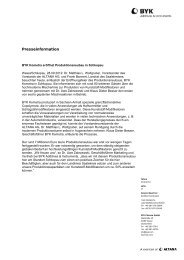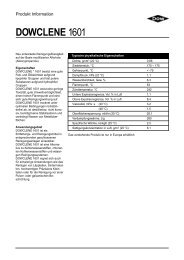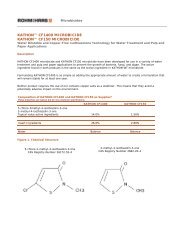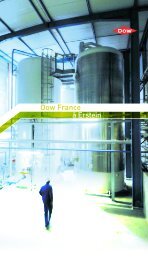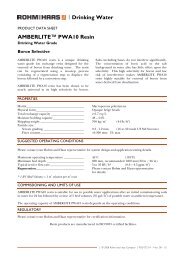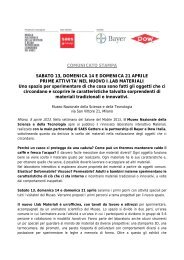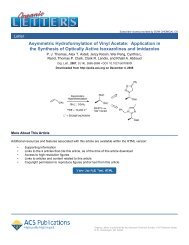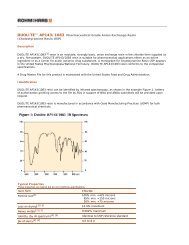ACULYN 44 -- Technical Data Sheet - The Dow Chemical Company
ACULYN 44 -- Technical Data Sheet - The Dow Chemical Company
ACULYN 44 -- Technical Data Sheet - The Dow Chemical Company
You also want an ePaper? Increase the reach of your titles
YUMPU automatically turns print PDFs into web optimized ePapers that Google loves.
Personal Care<br />
<strong>ACULYN</strong> <strong>44</strong> Rheology Modifier/Stabilizer<br />
An Excellent Thickener for Inorganic Sunscreen Formulations<br />
Description<br />
<strong>ACULYN</strong> <strong>44</strong> rheology modifier is a nonionic thickener based upon Hydrophobically-modified Ethoxylated URethane<br />
(HEUR) chemistry designed for personal care applications. As with most other <strong>ACULYN</strong> rheology modifiers, the<br />
polymer is a liquid product for easier handling and manufacturing efficiency. <strong>ACULYN</strong> <strong>44</strong> is offered at 35% solids,<br />
is stable from pH 2 to 12 and compatible with peroxide and other oxidizing agents. <strong>The</strong> polymer has a wellestablished<br />
toxicological profile and is safe in normal use.<br />
CTFA/INCI Name: PEG-150/Decyl Alcohol/SMDI Copolymer<br />
Features Applications<br />
� Highly associative<br />
� Broad compatibility<br />
� Yields clear gels<br />
� Near Newtonian rheology<br />
� Nonionic<br />
� Minimum shear dependence<br />
� Stable in anionic, cationic and nonionic systems<br />
� Cold-processable<br />
� Stable pH/viscosity response<br />
� Liquid<br />
� Acid compatibility<br />
� Salt tolerant<br />
� Peroxide stable<br />
� Lack of odor<br />
� Particulate stabilizer<br />
Benefits<br />
� Cationic silicone emulsions<br />
� Creams<br />
- Medicated creams<br />
- Make-up<br />
- Mascara<br />
- Alpha-Hydroxy acid creams<br />
� Hair products<br />
- Permanent waves<br />
- Hair rinse/conditioners<br />
- <strong>The</strong>rapeutic particulate containing shampoos<br />
- 2 or 3 in ONE shampoos/conditioners<br />
� Lotions<br />
- Aqueous antiperspirants<br />
- Astringents<br />
� Peroxide-containing formulations<br />
- Hair bleaches/dyes<br />
- Anti-acne (benzoyl peroxide) lotions<br />
- Hydrogen peroxide skin disinfectants<br />
� Sunscreen formulations<br />
- Inorganic sunscreens<br />
- Organic sunscreens<br />
� Easy to handle<br />
� Stabilization of hydrophobic (low solubility) components<br />
� No neutralization necessary<br />
� No preparation necessary<br />
� Compatible with nonionic, anionic, Zwitterionic and cationic surfactants<br />
� Non-hygroscopic<br />
� Increased manufacturing efficiency<br />
� Stable in pH 2 to 12 formulations<br />
� Allows for use of continuous production processes with use of in-line static mixers<br />
� Effective in thickening acid media such as solutions of organic acids<br />
� Can be processed with membrane pumps and, when diluted, with turbine mixers and high speed propellers<br />
� Thickens and stabilizes oxidizing media<br />
� Able to formulate clear products<br />
� Flexibility in choice of preservative system<br />
� Mild, soft, non-greasy, non-sticky, creamy<br />
� Supported by comprehensive environmental, health and safety data<br />
� Reproducible viscosity<br />
� Can be used with electrolytes<br />
� Cleared under CTFA/MITI/EINECS/TSCA/AICS/Canada<br />
� Ability to stabilize suspensions
Physical and <strong>Chemical</strong> Characteristics<br />
<strong>The</strong>se properties are typical but do not constitute specifications.<br />
Chemistry HEUR polymer<br />
Association very high<br />
Ionic nature nonionic<br />
Appearance hazy liquid<br />
Solvent 60/40 propylene glycol/water<br />
Solids, % 35<br />
pH (as supplied) 8 to 9<br />
Density 1.0 - 1.2<br />
Rheology stringy, tacky<br />
Shear thinning near Newtonian<br />
Viscosity, mPA s (as supplied) 11,000<br />
Pseudoplastic index<br />
(viscosity @ 6 rpm/viscosity @ 60 rpm)<br />
1.0 (2% polymer solids in water)<br />
INCI Name PEG-150/Decyl Alcohol/SMDI Copolymer<br />
<strong>ACULYN</strong> <strong>44</strong> Chemistry<br />
<strong>ACULYN</strong> <strong>44</strong> is a Hydrophobically-modified Ethoxylated URethane (HEUR) and is synthesized from decyl alcohol, a<br />
diisocyanate and a polyethylene glycol. <strong>The</strong> general structure for <strong>ACULYN</strong> <strong>44</strong> is shown below.<br />
Mechanism of Action<br />
<strong>ACULYN</strong> HEUR rheology modifiers thicken via an associative mechanism. <strong>The</strong> hydrophobic parts of HEUR polymers<br />
build up associations with other hydrophobes present in the formulation. However, because the <strong>ACULYN</strong> <strong>44</strong> is<br />
nonionic in nature, no neutralization is needed and the polymer will function equivalently in a pH range from 2<br />
through 12.<br />
<strong>The</strong> pendant hydrophobic groups in <strong>ACULYN</strong> HEUR polymers are free to build associations with one another and<br />
with other hydrophobes available in the formulation, such as surfactants, particulates, emulsion droplets and dyes.<br />
This phenomenon creates a network structure that results in a significant viscosity build.
<strong>The</strong>se associative structures can also act to stabilize and disperse particulates in a formulation.<br />
<strong>The</strong> chart below shows features indicative of the behavior of HEUR rheology modifiers under different conditions.<br />
Please note that these behaviors may vary to some extent according to specific formulations.<br />
All <strong>ACULYN</strong> rheology modifiers are easy to formulate, have good to excellent salt tolerance, compatibility with<br />
anionics and nonionics and low odor. HEUR polymers have excellent compatibility in low pH and cationic systems<br />
and excellent stability in one-part peroxide systems.<br />
Features of HEUR Rheolgy Modifiers<br />
Ease of formulation Good<br />
Associative Yes<br />
Salt tolerance<br />
NaCl<br />
Di/trivalent ions<br />
Shear thinning behavior Fair<br />
Excellent<br />
Excellent<br />
Solvent compatibility Good<br />
Low pH compatibility Excellent<br />
Anionic surfactant compatibility Good<br />
Nonionic surfactant compatibility Excellent<br />
Cationic surfactant compatibility Excellent<br />
Zwitterionic surfactant compatibility Excellent<br />
Peroxide stability<br />
1 part system<br />
2 part system<br />
Excellent<br />
Excellent<br />
Lack of odor Excellent
<strong>ACULYN</strong> <strong>44</strong> Behavior Profile<br />
<strong>ACULYN</strong> <strong>44</strong> rheology modifier possesses many properties that make this polymer highly desirable for use in<br />
personal care applications, as shown in the data presented below.<br />
Rheology<br />
Near-Newtonian Rheology<br />
Formulations using <strong>ACULYN</strong> <strong>44</strong> show a slight drop in viscosity between 0.5 and 1.5 rpm (very low shear rate). For<br />
higher shear rates, the viscosity is nearly Newtonian. This behavior allows the thickened product to flow easily<br />
from the container when poured.<br />
Effect of Temperature on Viscosity<br />
<strong>ACULYN</strong> <strong>44</strong> is supplied as a viscous liquid. To facilitate handling and dispersion the product can be heated up to<br />
75°C, resulting in decreased viscosities with increasing temperatures.
<strong>The</strong> lowering of the viscosity by increasing the temperature also assists in the dispersion of <strong>ACULYN</strong> <strong>44</strong>. Although<br />
the polymer will disperse at room temperature, a slight increase in the water temperature will facilitate the<br />
dispersion in a shorter period of time. Below is a graph that indicates the approximate time for dispersion of<br />
various levels of <strong>ACULYN</strong> <strong>44</strong> (on a product basis). This work was done with a 3 blade propeller turning at 1000<br />
rpm and a blade diameter to vessel ratio of 1 to 8.<br />
Compatibility<br />
pH Tolerance<br />
<strong>ACULYN</strong> <strong>44</strong> has a constant pH response at very low or very high pH’s as shown below.<br />
Peroxide Compatibility<br />
<strong>ACULYN</strong> <strong>44</strong> is compatible with peroxides and does not induce loss of active oxygen. To obtain significant viscosity<br />
and stability over time, an appropriate surfactant should be used in combination with <strong>ACULYN</strong> <strong>44</strong>.
<strong>ACULYN</strong> <strong>44</strong> has good stability in hydrogen peroxide. <strong>The</strong> stability of the polymer can be improved by combining<br />
the polymer with a surfactant that will associate with the <strong>ACULYN</strong> <strong>44</strong>.<br />
Stability of <strong>ACULYN</strong> <strong>44</strong> in Hydrogen Peroxide Solutions<br />
Viscosity, mPa s (12 rpm)<br />
3% <strong>ACULYN</strong> <strong>44</strong> Initial 2 Weeks<br />
3% H 2 O 2 1525 1300<br />
6% H 2 O 2 1250 1070<br />
12% H 2 O 2 960 880<br />
25% H 2 O 2 565 450<br />
Surfactant Synergies<br />
<strong>ACULYN</strong> <strong>44</strong> works by association. This means that the hydrophobic parts of the HEUR polymer build up<br />
associations with other hydrophobes present in the formulation. This property allows <strong>ACULYN</strong> <strong>44</strong> to demonstrate a<br />
marked synergistic effect when used in conjunction with fatty surfactants, pigments, particulates, and dyes. <strong>The</strong><br />
following graph shows the synergy of <strong>ACULYN</strong> <strong>44</strong> with dicetyl dimethyl ammonium chloride (DCDMAC).
Formulation and Use Guidelines<br />
<strong>ACULYN</strong> <strong>44</strong> rheology modifier is compatible with cationic surfactants, acids and peroxides as well as other<br />
ingredients commonly found in cosmetic and toiletry products.<br />
<strong>ACULYN</strong> <strong>44</strong> is shipped in a water/propylene glycol solvent that thickens directly upon addition to a formulation. To<br />
facilitate handling and dispersion, the product can be heated up to 75°C, resulting in decreased viscosities.<br />
<strong>ACULYN</strong> <strong>44</strong> rheology modifier should be added slowly and steadily near the periphery of the mixing tank. <strong>The</strong> rate<br />
of addition should be adjusted to allow uniform incorporation of the thickener. Rapid addition may cause excessive<br />
thickening or gelling due to highly localized thickener concentrations.<br />
To ensure optimum performance of the <strong>ACULYN</strong> <strong>44</strong> rheology modifier, the following procedure is recommended:<br />
1. Introduce most of the formulation water into the reactor.<br />
2. Add <strong>ACULYN</strong> <strong>44</strong> polymer and stir vigorously for a minimum of 5 minutes (see note).<br />
3. Add the most hydrophilic (high HLB) surfactants and ingredients and stir for a minimum of 5 minutes.<br />
4. Add the remaining components, saving the most hydrophobic component for last.<br />
Note: If the formulation does not contain a surfactant that helps dispersion, Step 2 should be extended to a<br />
minimum of 40 minutes. Either low speed paddle stirrers or high spin turbines are suitable.<br />
Environmental, Health and Safety Record<br />
Toxicology<br />
Acute Toxicology Profile<br />
Test/Species Results<br />
Oral LD 50 — rat > 5 g/kg non-toxic<br />
Dermal LD 50 — rabbit > 5 g/kg non-toxic<br />
Eye irritation — rabbit Non-irritating (US and EEC)<br />
Skin irritation — rabbit, male Primary Irritation Index (PII) = 0.0 — non-irritating<br />
US = United States classification<br />
EEC = European Economic Community classification<br />
Sensitization Toxicity Profile<br />
Test/Species Results<br />
Sensitization, Guinea pig Non-sensitizer<br />
Genetic Toxicity Profile<br />
Test/Species Results<br />
Ames Test Non-mutagenic with and without metabolic activation<br />
Ecotoxicity Profile<br />
Test/Species Results<br />
Algae EC 50 — 72 hr 229 mg/L — non-toxic<br />
Daphina magna EC 50 — 48 hr 992 mg/L — non-toxic<br />
Rainbow Trout LC 50 — 96 hr 750 mg/L — non-toxic
Overall Evaluation<br />
<strong>ACULYN</strong> <strong>44</strong> is considered non-toxic by single oral and dermal exposure, non-irritating to the skin and eyes, a nonsensitizer,<br />
non-mutagenic in the Ames assay, and non-toxic to aquatic organisms. This material is safe and<br />
appropriate for use in a broad range of rinse-off and leave-on personal care applications.<br />
<strong>ACULYN</strong> <strong>44</strong> is cleared under the major chemical inventories such as CTFA, MITI, EINECS, TSCA, AICS and Canada.<br />
Storage and Handling<br />
Storage<br />
<strong>ACULYN</strong> <strong>44</strong> is supplied at 35% solids with a maximum viscosity of 11,000 mPa.s at room temperature (25°C). <strong>The</strong><br />
polymer is supplied as clear to slightly opaque liquid that thickens to a clear liquid.<br />
<strong>ACULYN</strong> <strong>44</strong> can be extremely viscous and may coagulate at high temperatures. If stored at high temperatures, it<br />
may have to be stirred before use.<br />
<strong>The</strong> recommended storage temperature for <strong>ACULYN</strong> <strong>44</strong> is from 4°C to 49°C. <strong>The</strong> product will not freeze because of<br />
the propylene glycol, but will be very thick at colder temperatures and it will not flow. Product once subjected to<br />
cold temperatures will not perform appropriately.<br />
Material Safety <strong>Data</strong> <strong>Sheet</strong>s<br />
Rohm and Haas Material Safety <strong>Data</strong> <strong>Sheet</strong>s (MSDS) contain pertinent information that you may need to protect<br />
your employees and customers against any known health or safety hazards associated with our products. Under<br />
the OSHA Hazard Communication Standard, workers must have access to and understand MSDS on all hazardous<br />
substances to which they are exposed. Thus, it is important that you provide appropriate training and information<br />
to your employees and make sure they have available to them MSDS on any hazardous products in the workplace.<br />
Upon initial shipment of non-OSHA-hazardous and OSHA-hazardous products (including samples), Rohm and Haas<br />
<strong>Company</strong> sends the appropriate MSDS to the recipient. If you do not have access to one of these MSDS, please<br />
contact your local Rohm and Haas representative for a copy. Updated MSDS are sent upon revision to all<br />
customers of record. MSDS are also sent annually to all customers receiving products deemed hazardous under<br />
the Superfund Amendments and Reauthorization Act (SARA). MSDS should be obtained from suppliers of other<br />
materials recommended in this bulletin.<br />
Rohm and Haas <strong>Company</strong> is a member of the American Chemistry Council (ACC) and is committed to the ACC’s<br />
Responsible Care ® Program.<br />
<strong>ACULYN</strong> is a trademark of Rohm and Haas <strong>Company</strong>, or of its subsidiaries or affiliates. <strong>The</strong> <strong>Company</strong>’s policy is to register its trademarks<br />
where products designated thereby are marketed by the company, its subsidiaries or affiliates.<br />
<strong>The</strong>se suggestions and data are based on information we believe to be reliable. <strong>The</strong>y are offered in good faith, but without guarantee, as<br />
conditions and methods of use of our products are beyond our control. Rohm and Haas <strong>Company</strong> makes no warranties, either expressed or<br />
implied, as to the accuracy or appropriateness of this data. Rohm and Haas <strong>Company</strong> expressly disclaims any implied warranty of fitness for<br />
a particular use.<br />
We recommend that the prospective users determine for themselves the suitability of Rohm and Haas materials and suggestions for any use<br />
prior to their adoption.<br />
Suggestions for uses of our products or the inclusion of descriptive material from patents and the citation of specific patents in this<br />
publication should not be understood as recommending the use of our products in violation of any patent or as permission or license to use<br />
any patent of the Rohm and Haas <strong>Company</strong>.<br />
Material Safety <strong>Data</strong> <strong>Sheet</strong>s outlining known health and safety hazards and handling methods for our products are available on request.<br />
©Rohm and Haas, 2006 All rights reserved.<br />
April 2004<br />
PC0122002A_EUR


